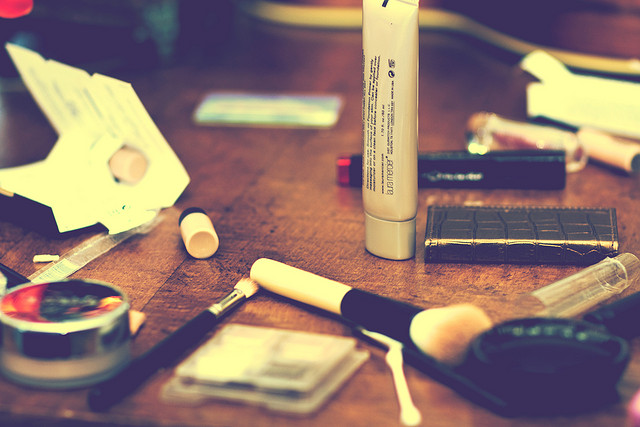Without setting out to do so, I’ve been a greenie for quite a while.
About 15 years ago, I made the switch to organic, non-GMO food without ever looking back. However, there is one area where I held out for a long time and that has to do with “green” cosmetics and body care.
While much of this has to do with the fact that there aren’t any set guidelines for use of the word “organic” or natural when it comes to cosmetics, a lot of it came down to price. In a nutshell, it’s not cheap to go green. (For example, I recently heard rave reviews about Lavera’s all-natural deodorant. After learning that it retails for $19 for 1.6 oz, my reaction was, “It better be for that price!)
However, after reading more the ingredients that goes into many common personal care products, i.e., coal, tar, parabens, phthalates, etc., and their possible link to cancer, reproductive problems and other sorts of maladies, I have decided that for myself, I would rather be safe than sorry.
Even if further research shows these things to be 100% safe, I am not losing anything by avoiding them or trying to reduce my contact with them in the meantime. At the same time, I have vowed not to go broke.
How this is possible?
Below are some tips to green up our personal care routines without going broke:
1. Think less is more.
More often than not, we have more stuff than we can actually use and that includes grooming and hygiene products. We need to ask ourselves: Do we really need 3 different bottles of body lotion and 3 bottles of body oil when they essentially all do the same thing? What’s the point in having several different brands of toothpaste/shampoo/etc. especially if we tend to reach for the same one over and over again?
One of things that was helpful to me was to spend an hour one weekend just going through the bathroom cabinets and closets and seeing what I had. In my search, I found several things I had forgotten I bought. I donated any unused or barely used products to my local homeless shelter and moved on to Step #2, which is discussed in greater detail below.
2. Be realistic about what you actually use every day.
For most of us, the bare minimum is soap/bodywash, toothpaste and deodorant. However, many have more complicated routines.
If you cannot remember, then document for two-three days every personal care product that you use. Be specific: don’t just say “make-up,” for instance. Rather document, “powder, blush, mascara and lipstick.”
After doing so, go back and look at what you use the most versus the stuff you seldom or never use. (It may be the case you decide to throw out or donate the latter.)
4. Pick your battles.
It’s not necessary or, in most cases, practical to pick a green alternative for every conventional cosmetic or grooming product.
For instance, I have already had a skin cancer scare and wear sunscreen every single day without fail rain or shine. I’ve tried nearly every brand under the sun and have only found one that goes on weightless, provides the necessary sun protection factor that I require and does not leave a white cast on my melanin-rich skin that doesn’t make me look like I am going to appear in the local production of Madame Butterfly.
Unfortunately, it’s not green in the least and the Environmental Working Group does not give it very high marks. Still, for me it is worth it. I figure the benefits I get from it far outweigh any drawbacks. (Plus, I figure I “balance” it out by avoiding parabens, etc., in my other beauty products.)
Others may decide that there is no way they are going to give up their favorite shampoo or the mascara brand they have been using since high school, and that is fine. Again, chose your battles.
5. Don’t be seduced by green marketing hype.
Like their conventional counterparts, green cosmetic companies are out to make money. Some make claims about “curing” wrinkles, “reversing” aging, etc. that are just as outrageous as some of the major mainstream companies. Learn to be skeptical. If it sounds too good to be true, then it probably is.
6. Consider making some of your own products and buying in bulk when possible.
There are books and websites aplenty with DIY beauty recipes. One of the best moisturizers I have ever used is a lotion bar I made myself using coconut oil, beeswax, and shea butter. (I found the recipe here. I also happened to already have the ingredients on hand, so the cost to me was mere pennies.)
If you’re going the DIY route, then buying the ingredients in bulk can make a lot of sense economically.
Also if you’re interested in a product because of one particular ingredient, then it may make sense to buy that one ingredient, if possible.
For instance, when an ultra-expensive all-natural face cream was tooting that its “miracle” ingredient was argan oil, I found an online store that sold various sizes of 100%, organic argan oil for a fraction of the price of the cream. I found the oil to be quite good and used it on my face, body, and as an eye make-up remover.
In conclusion, deciding whether or not to green one’s personal care routine is ultimately up to the individual but as the above tips show, it is possible to do so without breaking the bank.
Plus, by making do with less in general, all of us can do more for the environment and save money at the same time.
Love elephant and want to go steady?
Sign up for our (curated) daily and weekly newsletters!
~
~
~
Editor: Travis May
Photos: Flickr/Lauren Nelson







Read 3 comments and reply